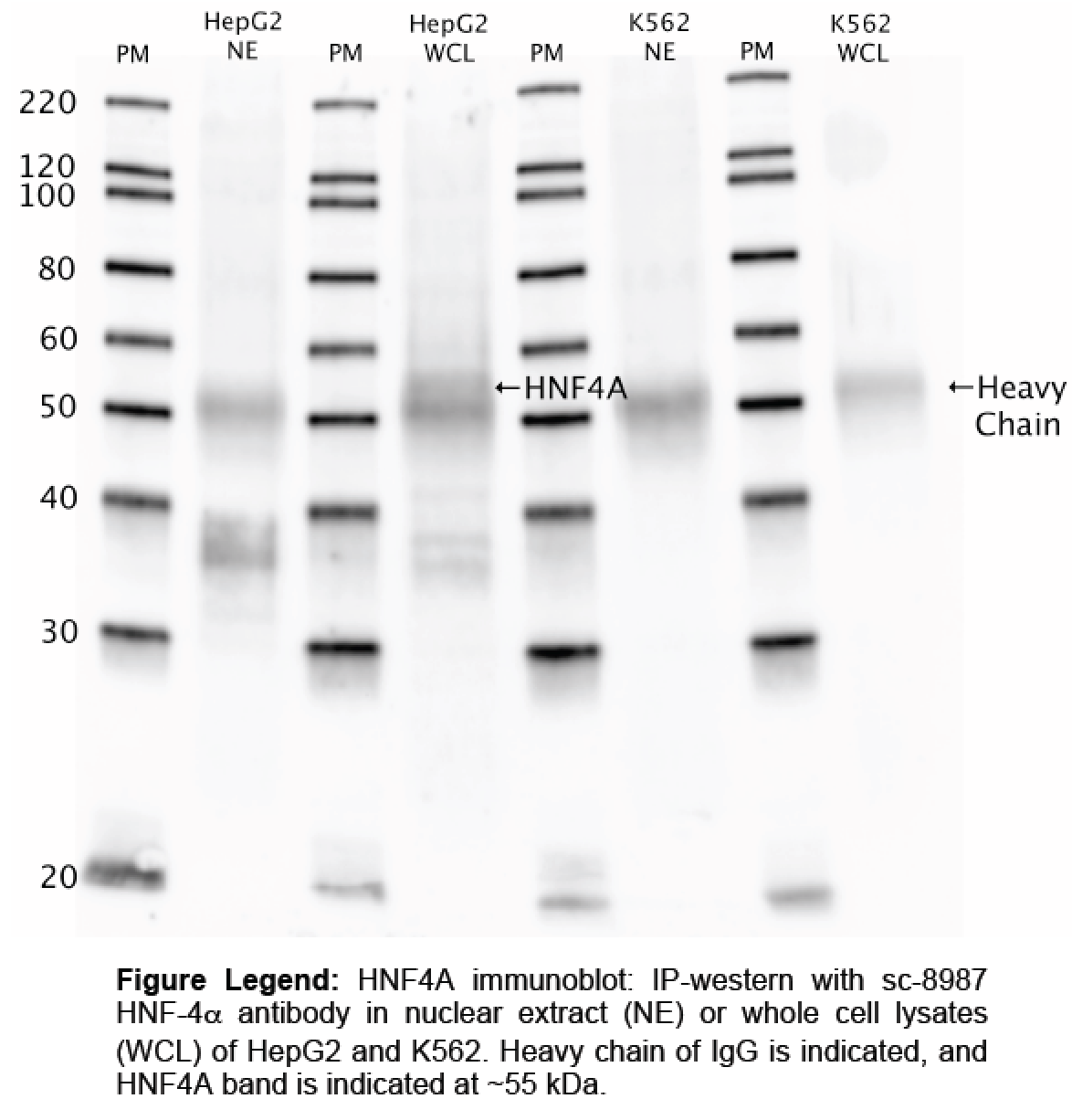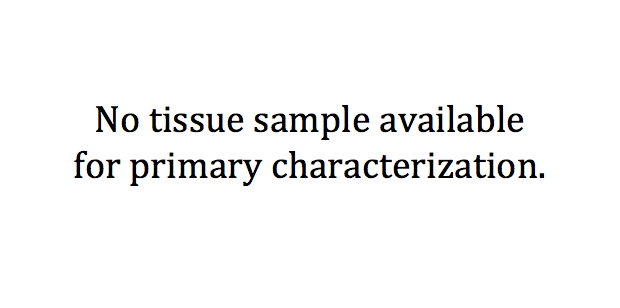ENCAB000AHP
Antibody against Homo sapiens HNF4A
Homo sapiens
HepG2, liver
characterized to standards with exemption
Homo sapiens
K562
not characterized to standards
- Status
- released
- Source (vendor)
- Santa Cruz Biotech
- Product ID
- sc-8987
- Lot ID
- G1309
- Characterized targets
- HNF4A (Homo sapiens)
- Host
- rabbit
- Clonality
- polyclonal
- Isotype
- IgG
- Antigen description
- Epitope corresponding to a.a. 295-465 mapping at the C-terminus of HNF4A of human origin.
- External resources
Characterizations
HNF4A (Homo sapiens)
Method: immunoprecipitation followed by mass spectrometry
not compliant
- Caption
- ENCODE data standards recognizes various methodologies for secondary validation of antibodies. Among these methodologies is immunoprecipitation followed by mass spectrometry analysis. Briefly, HepG2 whole cell lysates were immunoprecipitated using primary antibody, and the IP fraction was loaded on a 12% acrylamide gel and separated with a Bio-Rad PROTEAN II xi system. Gel was stained with Coomasie Blue in order to visualize marker bands. A gel fragment corresponding to the band indicated above in the western blot image at ~55 kDa and a second fragment at ~38 kDa were excised and sent to the University of Alabama at Birmingham Cancer Center Mass Spectrometry/Proteomics Shared Facility. There the samples were run on an LTQ XL Linear Ion Trap Mass Spectrometer with alternating collision-induced dissociation and electron-transfer dissociation. Peptides were identified using MASCOT (Matrix Science), with probability based matching at p < 0.05. Subsequent analysis was performed in Scaffold (Proteome Software, Inc.) at 0.0% protein FDR and 1.7% peptide FDR. As per ENCODE data standards, all Scaffold results are listed below, including common contaminants. Target protein is highlighted in bold font.
- Submitted by
- Richard Myers
- Lab
- Richard Myers, HAIB
- Grant
- U54HG004576
HNF4A (Homo sapiens)
HepG2K562
exempt from standards
- Caption
- Whole cell lysates or nuclear extracts were immunoprecipitated using primary antibody, and the IP fraction was loaded on a 12% acrylamide gel and separated with a Bio-Rad PROTEAN II xi system. After separation, the samples were transferred to a nitrocellulose membrane with an Invitrogen iBlot system. Blotting with primary (same as that used for IP) and secondary HRP-conjugated antibodies was performed on an Invitrogen BenchPro 4100 system. Visualization was achieved using SuperSignal West Femto solution (Thermo Scientific).
- Submitter comment
- We'd like an exemption for this characterization.
- Reviewer comment
- The antibody review panel will pass (with exemption) any immunoprecipitation characterization that meets all standards for ENCODE2. ENCODE2 did not require an IgG control
- Submitted by
- Richard Myers
- Lab
- Richard Myers, HAIB
- Grant
- U54HG004576
HNF4A (Homo sapiens)
compliant
- Caption
- The motif for target HNF4A is represented by the attached position weight matrix (PWM) derived from ENCFF922YKH and ENCFF703MBR. Motif enrichment analysis was done by Dr. Zhizhuo Zhang (Broad Institute, Kellis Lab) using known motifs (http://compbio.mit.edu/encode-motifs/) and previously published ChIP-seq data (http://www.broadinstitute.org/~zzhang/motifpipeline/data/TrainSetInfo.txt). The accept probability score of the given transcription factor was calculated using a Bayesian approach. This analysis also includes three motif enrichment scores, computed by overlapping the motif instances with the given ChIP-seq peak locations. For more information on the underlying statistical methods, please see the attached document. From ENCFF922YKH: Accept probability score: 0.980692270556, Global enrichment Z-score: 7.73224741061, Positional bias Z-score: 9.73903092699, Peak rank bias Z-score: 7.9240626667. From ENCFF703MBR: Accept probability score: 0.980692270556, Global enrichment Z-score: 8.40991465285, Positional bias Z-score: 10.0966485197, Peak rank bias Z-score: 6.9130845021, Enrichment rank: 4.0.
- Submitted by
- Aditi Narayanan
- Lab
- Richard Myers, HAIB
- Grant
- U54HG006998
- Download
- MOTIFENRICHMENT_ENCAB000AHP.png
HNF4A (Homo sapiens)
liver
exempt from standards
- Caption
- The ENCODE Binding Working Group finds for some valuable tissues that recreating a primary on well characterized antibodies is not cost effective. Therefore, they allow exemption from standards for these tissues.
- Submitter comment
- The lab is asking for an exemption for liver cells due to the lack of resource to make a primary characterization for them
- Reviewer comment
- Exempted by the Feb 29, 2016 antibody review panel
- Submitted by
- Richard Myers
- Lab
- Richard Myers, HAIB
- Grant
- U54HG006998
- Download
- No_tissue.png


